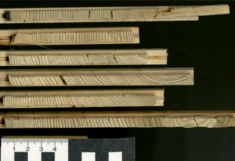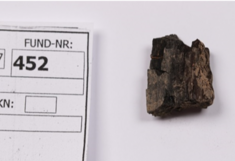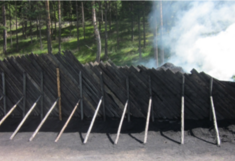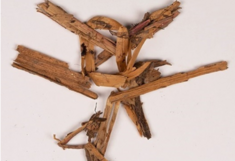Material aging in the environment
-
MD-Dating: Use of molecular decay to predict age
Chemical changes over time can be used to determine different processes. If time leads to slow and uniform degradation processes, it seems likely to use the taphonomic pattern as proxy for the age of a sample.
A literature review about this topic can be found at (open access):
-
Use of molecular decay of wood to predict age or storage condition
Preservation of wood in living trees and under waterlogged and dry conditions leads to comparable chemical changes. Other conditions can lead to different speeds or even different behavior over time. Samples from the prehistoric salt mine in Hallstatt, Upper Austria, clearly revealed a different behavior under these storage conditions. Dating tools were prepared for spruce, fir, larch, and oak wood. Different storage conditions, different species and the extension of the existing models in time and spatial coverage are focal points of further investigations.
publications dealing with the molecular decay in wood:
Tintner J., Spangl B., Grabner M., Helama S., Timonen M., Kirchhefer A.J., Reinig F., Nievergelt D., Krąpiec M., Smidt E. (2020) MD dating: molecular decay in pinewood as a dating method. Sci Rep 10:11255, doi: 10.1038/s41598-020-68194-w
Tintner J., Spangl B., Reiter F., Smidt E., Grabner M. (2020) Infrared spectral characterization of the molecular wood decay in terms of age. Wood Sci Techn, 54, 313-327, doi 10.1007/s00226-020-01160-x.
Tintner J., Smidt E., Tieben J., Reschreiter H., Kowarik K., Grabner M. (2016) Aging of wood under long-term storage in a salt environment. Wood Sci Techn 50 (5), 953-961, doi 10.1007/s00226-016-0830-4.
-
Use of molecular changes of charcoal to classify different age periods and to describe the pyrolysis conditions
Charcoal pieces are among the most common organic findings in archaeological sites. Often used for dating purposes they demonstrate its recalcitrance in soils against microbial degradation where most other organic matter has disappeared. Charcoal pieces are thought to play a crucial role in anthropogenic and even natural soils that have been established over centuries and millenia. Besides the influence on soil fertility with regard to the application of biochar on agricultural land their effect on the long-term carbon storage became a focal point in the discussion.
publications dealing with the molecular decay in charcoal and pyrolysis conditions:
Smidt E., Tintner J., Nelle O., Oliveira R.R., Patzlaff R., Novotny E.H., Klemm S. (2020) Infrared spectroscopy refines chronological assessment, depositional environment and pyrolysis conditions of archeological charcoals. Sci Rep 10:12427, doi: 10.1038/s41598-020-69445-6
Tintner J., Fierlinger R., Gerzabek H., Pfeifer C., Smidt E. (2020) Pyrolysis profiles of a traditional circular kiln in Austria and a drum kiln in Namibia. J Anal Appl Pyrol 150, 104865, doi 10.1016/j.jaap.2020.104865
Tintner J., Preimesberger C., Pfeifer C., Theiner J., Ottner F., Wriessnig K., Puchberger M., Smidt E. (2020) Pyrolysis profile of a rectangular kiln – natural scientific investigation of a traditional charcoal production process. J Anal Appl Pyrol 146, 104757, doi 10.1016/j.jaap.2019.104757.
Tintner J., Preimesberger C., Pfeifer C., Soldo D., Ottner F., Wriessnig K., Rennhofer H., Lichtenegger H., Novotny EH., Smidt E. (2018) Impact of pyrolysis temperature on charcoal characteristics. Ind Eng Chem Res 57(46): 15613-15619, doi 10.1021/acs.iecr.8b04094.
Smidt E., Tintner J., Klemm S., Scholz UM. (2017) FT-IR spectral and thermal characterization of ancient charcoals - a tool to support archaeological and historical data interpretation. Quat Int 457, 43-49, doi 10.1016/j.quaint.2016.11.031.
-
Use of molecular decay of amendments to adobe bricks and plastering to predict age
Based on the results of wood, also other organic material came into the focus of dating via its taphonomy. A special interest arose on organic amendments to adobe bricks. Commonly, we can find such materials actively or not actively amended in all techniques of adobe brick construction.
Unfortunately such samples are scarcely collected. A first sample was available from an old storage house near Immendorf (N48°38′20" E16°07′20"), Lower Austria. The house has been constructed with an adobe brick technique locally called “Quaderstock” typical for the late 18th century and the early 19thcentury. In the course of a preliminary work one of these bricks was crushed and organic residues were picked out. The main compound was straw, ancillary also charcoal pieces, husks, and some woody remnants were found. Recent straw was taken as reference. Recent and aged straw found in the adobe brick were characterized by means of infrared spectroscopy. First results are promising.
publications dealing with the molecular decay in earth constructions and plasters (open access)
Tintner J., Rennhofer H., Kennedy CJ., Revie WA., Weber H., Pavlik C., Lanszki J. (2020) Recalcitrance of hair in historical plasters. Poly Degr Stab 181, 109333, doi: 10.1016/j.polymdegradstab.2020.109333
Tintner J., Roth K., Franz Ottner F., Syrová-Anýžová Z., Žabičková I., Wriessnig K., Meingast R., Feiglstorfer H. (2020) Straw in Clay Bricks and Plasters—Can We Use Its Molecular Decay for Dating Purposes? Molecules (MDPI), 25(6), 01419, doi 10.3390/molecules25061419
Contact: J. Tintner-Olifiers




